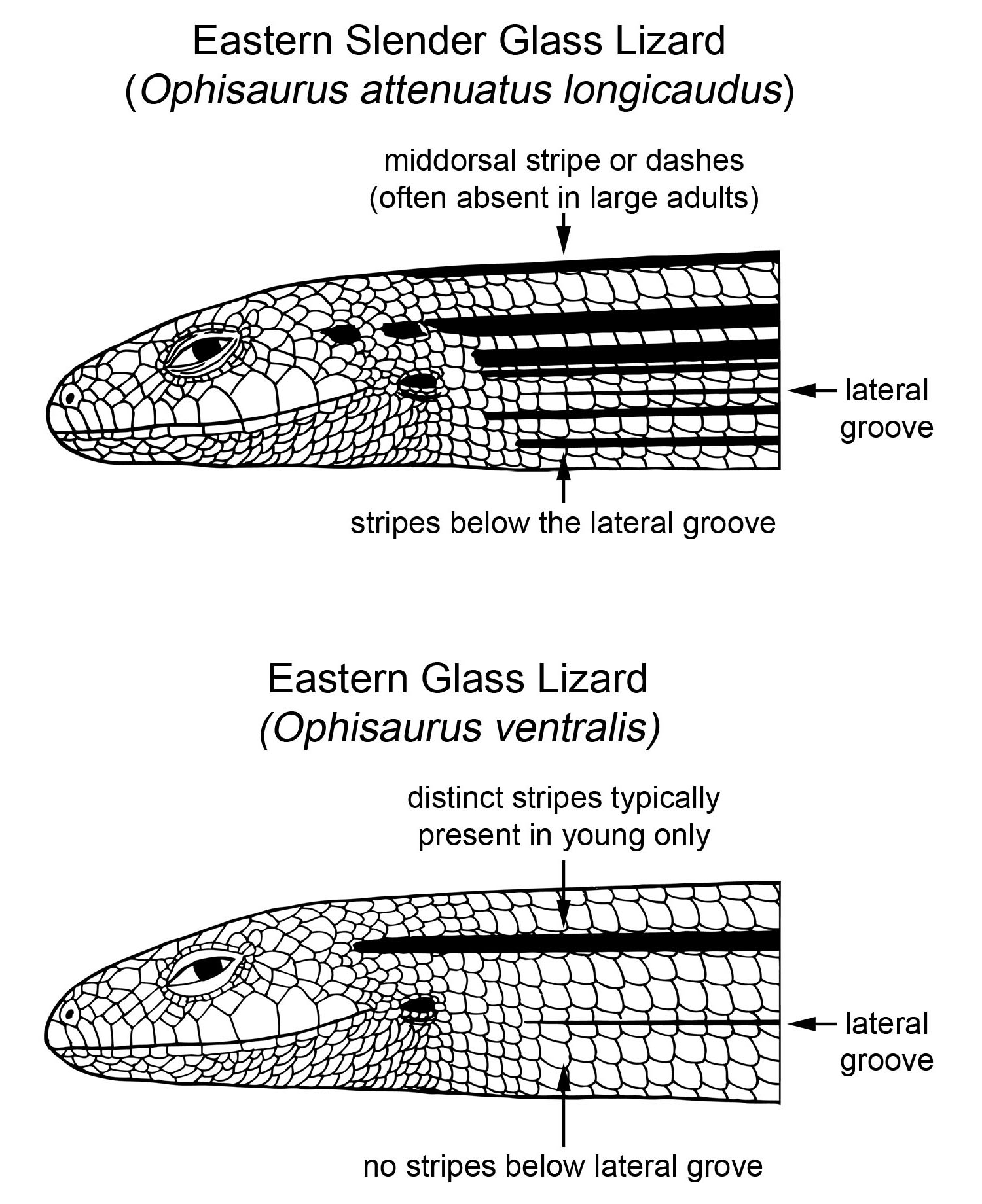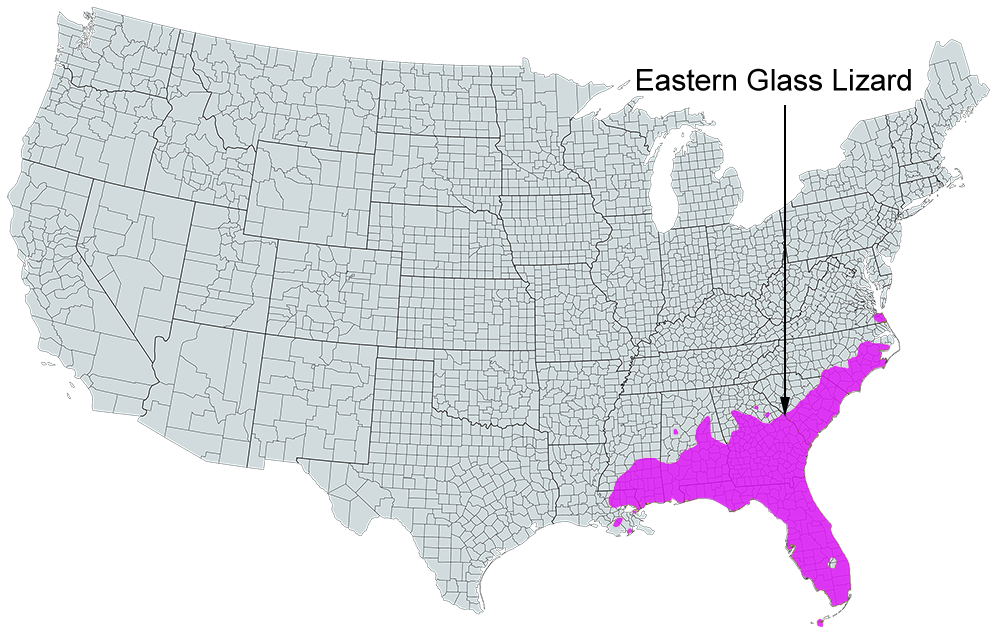Eastern Glass Lizard
Ophisaurus ventralis
Common Name: |
Eastern Glass Lizard |
Scientific Name: |
Ophisaurus ventralis |
Etymology: |
|
Genus: |
Ophisaurus is derived from the Greek words ophio meaning "snake" and sauros meaning "lizard". |
Species: |
ventralis is from the Latin word venter meaning "of the belly", referring to the serpentine form of locomotion used by this lizard. |
Average Length: |
18 - 42.6 in. (45.7 - 108.3 cm) |
Virginia Record Length: |
23.8 in. (60.4 cm) |
Record length: |
42.6 in. (108.3 cm) |
Systematics: Described originally as Anguis ventralis by Carolus Linnaeus in 1766 from a specimen sent to him by Alexander Garden from "Carolina." Neill (1949) restricted the type locality to the vicinity of Charleston, South Carolina. The genus Ophisaurus was first used for this species by Daudin (1803). No subspecies are recognized. See the Ophisaurus attenuatus account for additional remarks on the use of the name in the Virginia literature.
Description: A slender, snakelike, legless lizard reaching a maximum snout-vent length (SVL) of 306 mm (12.0 inches) and a maximum total length of 1,083 mm (42.6 inches) (Conant and Collins, 1991). In Virginia, maximum known SVL is 290 mm (11.4 inches) and maximum total length is 604 mm (23.8 inches, specimen with incomplete tail). Tail length/total length of lizards with complete tails was 65.2-69.6% (ave. = 67.4, n = 2) in the Virginia sample. Tail length was 1.9-2.3 x body length. A deep, lateral groove is present on each side of the body.
Scutellation: Scales smooth, squarish to rhomboidal in shape, overlapping, and glossy; scale rows around midbody between lateral grooves 15 (40.0%, n = 5) or 16 (60.0%); ventral rows 10; ven- trals 105-107 (ave. = 105.8 ± 0.8, n = 5); scales along lateral groove 106-109 (ave. = 107.0 ± 1.4, n = 5); infralabials 10/10 (60.0%, n = 5) or 11/11 (40.0%); supralabials 10/10 (60.0%, n = 5) or 11/11 (40.0%); supranasals present; frontonasal separated from rostral; preanal scales 7; mental single; postmentals 2.
Coloration and Pattern: Dorsum often with a broad tan stripe (6 scales wide) that may extend to tip of tail; no dark, narrow middorsal stripe; brown dorsal scales in large adults may be edged in black and have numerous small white dots; 1-2 dark black or greenish stripes occur on each side above lateral groove; a white area lies between them and lateral groove; dark stripes broaden with age and old individuals nearly uniformly peppered green (or black) and white above lateral groove; black and greenish scales tipped in white on lower posterior corners only; no stripes below lateral grooves; venter of body and tail white; 3-7 vertical white bars bordered by black on neck and head between eye and lateral groove. The green color changes to black in preservative, but otherwise museum specimens are patterned as described. The fragile tail is easily broken and the regenerated portions are brown.
Sexual Dimorphism: The single adult male from Virginia (290 mm SVL) was larger but had a similar number of scales along the lateral groove (108) compared with the three adult females (230-277 mm SVL, ave. = 253.3 ± 23.5; scales 106-109, ave. = 106.8 ± 1.5). Sexual dimorphism index was -0.14. There are no apparent sexual differences in color and pattern.
Juvenile: Juveniles have little black, greenish, or white pigment on the dorsum except for 1 dark, narrow lateral line. The tan dorsum lacks a middorsal stripe, and the black lateral stripes extend to the tip of the tail. The vertical white bars on the side of the head and neck are pronounced. Immature individuals at least as large as 120 mm SVL retained juvenile coloration. Size at hatching was 123-139 mm total length (ave. = 128.7 ± 9.0, n = 3) (Schwab, 1992).
Confusing Species: This species may be confused only with Ophisaurus attenuatus, which has dark stripes below the lateral groove and lacks the vertical white bars on the side of the neck and head.

Geographic Variation: McConkey (1954) listed an average of 103.7 ± 2.7 (98-109, n = 50) scales along the lateral groove for the species rangewide. The count for the small Virginia sample averaged slightly higher.
Biology: Eastern Glass Lizards are found in pine flatwoods, mesic hammocks, wet meadows, maritime forests, and damp grassy areas in sandy environments, as well as near marshes (McConkey, 1954; Martof et al., 1980). The few lizards found in Virginia have been either in maritime forests or in grassy areas near marshes. Hamilton and Pollack (1961) noted numerous individuals being plowed out of loamy soil in Alabama. Palmer and Braswell (in press) reported this species to be active in early morning and at dusk in North Carolina. McConkey (1954) noted that O. ventralis is probably crepuscular. The seasonal activity period is unknown. Virginia specimens were collected March through August.
Ophisaurus ventralis forages underground and in grass cover. A single, large grasshopper (Orthoptera) was found in an immature female from Virginia. Hamilton and Pollack (1961) reported the following prey types from Alabama and Georgia: caterpillars, bush katydids, grasshoppers, mole crickets, cockroaches, ground beetles, scarab beetles, darkling beetles, click beetles, termites, common lacewing, isopods (pillbugs), crayfish, spiders, millipedes, centipedes, earthworms, mollusks, Little Brown Skinks (Scincella lateralis), an unidentified skink (Plestiodon), Southeastern Crowned Snakes (Tantilla coronata), Northern Brownsnakes (Storeria dekayi), and mammal hair, possibly the white-footed mouse (Peromyscus). They also found that five individuals had remains of other O. ventralis in their stomachs (cannibalism) and that one had eaten eggs of a conspecific. Predators of this species are unknown, but probably include feral pigs (Sus scrofa) in the Virginia portion of its range.
Females of this species are oviparous and lay 5-15 eggs in June and July (Noble and Mason, 1933; McConkey, 1954; Mount, 1975; Gibbons and Sem- litsch, 1991). Nests are depressions in loamy and sandy soil, and females coil about the eggs during nesting (Mount, 1975; Gibbons and Semlitsch, 1991). Glass lizard females will not defend their eggs as will female skinks (Plestiodon), but will gather the eggs back into the nest if they are scattered (Noble and Mason, 1933). A female with eggs was found in Virginia on 10 August (Schwab, 1992) and a captive female laid eggs on 23 June (Schwab, 1988b). Clutch sizes were six and seven. Eggs measured 20.0-22.0 x 12.9-14.1 mm (ave. = 21.3 ± 0.6 x 13.3 ± 0.3, n = 13) (Schwab, 1988b, 1992). Three of the eggs found under natural conditions hatched on 19 August (Schwab, 1992).
The population biology of this species has not been studied. These lizards are very active. Basking occurs in open sun on the ground with only part of their body exposed. They will thrash about when caught, bite if they can, and autotomize the tail if it is held.
Remarks: The "joint snake" myth described in the Ophisaurus attenuatus account equally applies to this species.
Prior to 1954, all glass lizards were called Ophisaurus ventralis. McConkey published his monograph that year demonstrating that there were three species, not one (Palmer [1987] recently described a fourth species). His information led him to conclude that only O. attenuatus longicaudus occurred in Virginia. Ophisaurus ventralis was not known from Virginia until 16 May 1981 when C. A. Pague, D. A. Merkle, and I collected the first (DOR) specimen in False Cape State Park (Pague et al., 1983).
A juvenile specimen of O. ventralis, found on a road near Aspen, Charlotte County, in March 1983 by the late R. N. Bader (pers. comm.), is considered an unintentional release. Bader reported that bales of hay had recently been brought in from South Carolina and the lizard may have rafted to Virginia in one of them.
Conservation and Management: Ophisaurus ventralis is listed as threatened under Virginia law (Mitchell and Pague, 1991b). Both federal and state authorities on whose land this species occupies should have active management plans to protect this element of our natural heritage. This management should include protection and maintenance of all grassy habitats near marshes. All plans for development of waterfowl impoundments and alteration of any grassland habitat should be critically reviewed for impacts on populations of this lizard. An inventory of southeastern Virginia should be conducted with appropriate capture techniques to determine whether this species occurs in other locations. All aspects of its population biology should be studied for information useful to the development of realistic management plans.
References for Life History
Photos:
*Click on a thumbnail for a larger version.
Verified County/City Occurrence in Virginia
CITIES
Virginia Beach
Verified in 0 counties and 1 cities.
U.S. Range










